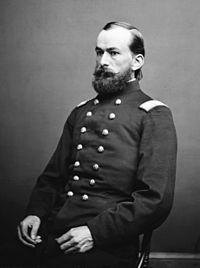- Asa P. Blunt
-
Asa Peabody Blunt 
As a Colonel in 1862Born October 19, 1826
Danville, VermontDied October 4, 1889 (aged 62)
Manchester, New HampshirePlace of burial Pine Grove Cemetery,
Manchester, New HampshireAllegiance  United States of America
United States of America
UnionService/branch United States Army
Union ArmyYears of service 1861–1888 Rank Major General Unit 3rd Vermont Infantry
6th Vermont Infantry
12th Vermont Infantry
2nd Vermont BrigadeBattles/wars American Civil War
*Battle at Lee's Mills
*Battle of Savage's StationAsa Peabody Blunt (October 19, 1826 – October 4, 1889) was a draughtsman and a general in the Union Army during the American Civil War.
Contents
Early life
Blunt was born in Danville, Vermont. In 1850, Asa and his wife Mary were living in Southampton, New York, where he was an overseer in a cotton mill. By 1860, they were living in St. Johnsbury, Vermont. Blunt was a draughtsman for Erastus and Thaddeus Fairbanks.
Civil War
Blunt was appointed adjutant, 3rd Vermont Infantry, on June 6, 1861, and was mustered into Federal service on July 16. On September 25, he was promoted to lieutenant colonel, 6th Vermont Infantry, and then Colonel of the 12th Vermont Infantry on September 19, 1862. On October 27, the 2nd Vermont Brigade was formed from the 12th, 13th, 14th, 15th, and 16th, Vermont Infantry regiments, and Blunt assumed temporary command of the brigade as the ranking colonel, filling this position until December 7, when Brigadier General Edwin H. Stoughton arrived and assumed command.
Stoughton was not popular with the officers and men of the brigade, so when he was captured by Confederate partisan John S. Mosby on March 9, 1863, few mourned his loss. Colonel Blunt assumed command of the brigade again, turning it over to the new brigade commander, Brigadier General George J. Stannard, on April 20.
By the end of June, most of the brigade was waiting to muster out, their nine months obligation ended. But Robert E. Lee's incursion into Pennsylvania delayed that for a few weeks, and the brigade finally got to see some action. Blunt's 12th and the 15th regiments, however, were left behind in Emmitsburg, Maryland, guarding the supply trains, and were not able to participate in the brigade's flanking movement that helped stop Pickett's Charge on July 3 at the Battle of Gettysburg. On July 4, Blunt's regiment was released to return to Vermont, and he mustered out with the regiment on July 14, 1863.
Just more than six months later, On February 24, 1864, Blunt was appointed Captain and Assistant Quartermaster, Volunteers, and was ordered to report to the Commanding General, Department of Virginia and North Carolina, for duty in the Quartermaster's Department, which duties he assumed on April 25. He became the Depot Quartermaster for the Army of the James on May 4, 1864, and served in this position until late 1865. On March 13, he was rewarded for his meritorious service at the Battle at Lee's Mills and Savage's Station with a brevet promotion to brigadier general. He also received brevet ranks of major, lieutenant colonel and colonel, Quartermaster's Department, on June 9.
Postwar life
On July 14, he was transferred to Fort Monroe, remaining there until July 1866. In late August, he was transferred to the position of Chief of Quartermaster Department of the Potomac.
He received a Regular Army commission as Captain and Assistant Quartermaster on March 28, and the same day, brevets to major and lieutenant colonel. On April 5, 1867, he was ordered to duty in connection with the National Cemeteries in the valleys of the James and Appomattox rivers and south of Richmond, and on April 11 appointed Chief Quartermaster, First Military District, with headquarters in Richmond. He was later ordered to Washington, D.C., and placed in charge of Lincoln Depot and the various National Cemeteries in the Department of Washington. By March 1, 1869, he was Department Quartermaster in Charleston, South Carolina.
Between 1877 and 1888 General Blunt was Commandant of the United States Disciplinary Barracks at Fort Leavenworth, Kansas.
He died on October 4, 1889, and is buried in Pine Grove Cemetery, Manchester, New Hampshire.
See also
References
- Benedict, G. G., Vermont in the Civil War. A History of the part taken by the Vermont Soldiers And Sailors in the War For The Union, 1861-5. Burlington, VT.: The Free Press Association, 1888, i:i 128, 209, 217, ii: 402-405, 417, 420-421, 423, 430-432, 434, 446, 782.
- Chadwick, Albert G., Soldiers' Record of the Town of St. Johnsbury, Vermont, in the War of the Rebellion, 1861-5, St. Johnsbury, VT: C. M. Stone & Co., 1883, pp. 25–26.
- Boatner, Mark M., The Civil War Dictionary, New York: Vintage Books, 1959, 1991 edition, p. 71.
- Heitman, Francis B.. Historical Register and Dictionary of the United States Army, 1789-1903. Vol. 1. Washington, D.C.: U.S. Government Printing Office, 1903.
- Peck, Theodore S., compiler, Revised Roster of Vermont Volunteers and lists of Vermonters Who Served in the Army and Navy of the United States During the War of the Rebellion, 1861-66. Montpelier, VT.: Press of the Watchman Publishing Co., 1892, pp. 70, 181, 485, 677, 735, 747.
- United States Census for the following years and place: 1850, Southampton, Suffolk Cty, New York; 1860, St.Johnsbury, Caledonia Cty, Vermont (incorrectly transcribed as Blunk), 1870, Manchester, Hillsborough Cty, New Hampshire, 1880, Manchester, Hillsborough Cty, New Hampshire, 1890 Special Schedule of Veterans and Widows, Manchester, Hillsborough Cty, New Hampshire.
External links
Categories:- 1826 births
- 1889 deaths
- People of Vermont in the American Civil War
- United States Army generals
- Union Army generals
- 2nd Vermont Brigade
- People from St. Johnsbury, Vermont
- Quartermasters
Wikimedia Foundation. 2010.
